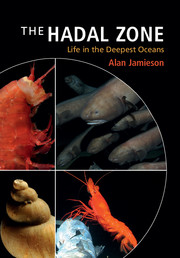Book contents
- Frontmatter
- Dedication
- Contents
- Preface
- Acknowledgements
- Part I History, geology and technology
- 1 The history of hadal science and exploration
- 2 Geography and geology
- 3 Full ocean depth technology
- Part II Environmental conditions and physiological adaptations
- Part III The hadal community
- Part IV Patterns and current perspectives
- Appendix
- References
- Index
- Plate section
2 - Geography and geology
from Part I - History, geology and technology
Published online by Cambridge University Press: 05 February 2015
- Frontmatter
- Dedication
- Contents
- Preface
- Acknowledgements
- Part I History, geology and technology
- 1 The history of hadal science and exploration
- 2 Geography and geology
- 3 Full ocean depth technology
- Part II Environmental conditions and physiological adaptations
- Part III The hadal community
- Part IV Patterns and current perspectives
- Appendix
- References
- Index
- Plate section
Summary
The geography and geology of the hadal zone is somewhat unique and is more similar to habitats such as canyons and seamounts than to the other depth-stratified biozones such as the abyssal and bathyal zones. This is because the trenches are enclosed, distinct geological features, often isolated from one another by thousands of kilometres. Furthermore, trenches are more complex than simply ‘areas deeper than 6000 m’. They are formed by immense geological forces which, on one hand, provide a unique geological, biological and environmental setting, however, on the other hand, these forces result in the devastating earthquakes and tsunamis for which they are better known.
For the purposes of this book, an analysis of global trench locations and topography was undertaken by Dr Tomasz Niedzielski from the Department of Cartography at the University of Wrocław in Poland, using ArcMap 9.3.1 under ArcInfo licence, provided by ESRI. The abyssal–hadal boundary of 6000 m was automatically selected across contours imposed on imported bathymetry (30 arcsec grid released by GEBCO). The maps were projected to the cylindrical equal area projection with a central meridian 180º and a standard parallel 30º S, with a subkilometre spatial resolution. The analysis of the topography was focused further by slicing the bathymetry into 500 m depth bins. This approach permitted the extraction of habitat size (km−2), projected area (km−2), mean slope (º) and water volume (km−3). These data were used to provide a list of up-to-date locations and depths of the trenches, with additional information on size and volume characteristics. The exact depth of each trench should be taken as indicative since the map resolution may not detect very small depressions within the deepest point.
- Type
- Chapter
- Information
- The Hadal ZoneLife in the Deepest Oceans, pp. 22 - 44Publisher: Cambridge University PressPrint publication year: 2015



